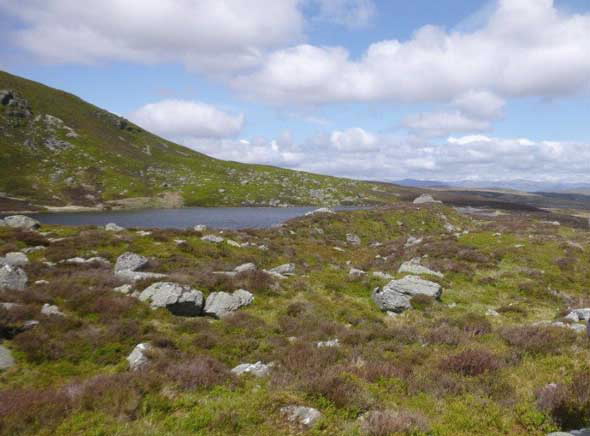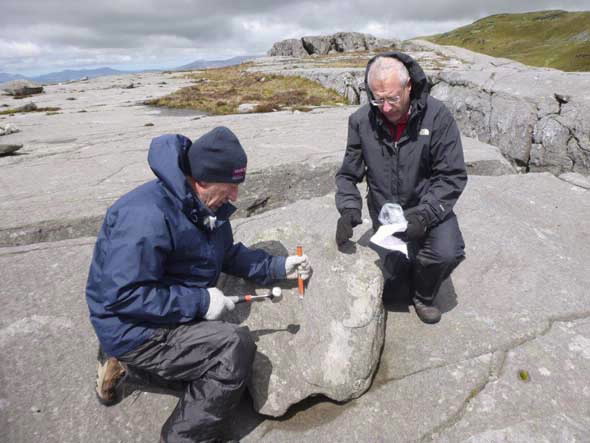
One of the world’s authorities on European and Mediterranean glaciers, Prof Philip Hughes of the University of Manchester in the UK, recently relied on ANSTO expertise to use cosmogenic exposure dating to study the last retreat of the Welsh Ice Cap in northern Wales (pictured above). Scientists study glaciers because they are good indicators of past climate and this knowledge can be used to plan for future climate variability.
This study is part of a larger UK university consortium BRIT-ICE, commissioned to model the extent, thickness and retreat rate of the British Ice Sheet due to global warming after the Last Glacial Maximum about 20,000 to 25,000 years ago.
A collaboration between Prof Hughes, Prof Neil Glasser of Aberystwyth University in Wales and ANSTO’s Principal Research Scientist Dr David Fink has provided some new and exciting insights into the rapid thinning of the last Welsh Ice sheet approximately 19,500 years ago (~19.5 ka).
The subject of the research is the study of glacial dynamical processes that shaped the alpine landscape visible today. Various glacial deposits, such as outwash gravels resulting from ice melt and moraines formed at maximum ice extent, are excellent records of regional paleo-climate.
Using the technique of cosmogenic dating and ANSTO’s accelerator mass spectrometry facilities it is possible to date when these deposits were exposed since the time the glacier commenced its retreat, or when the climate warmed.
“We measure the concentration of cosmogenic radionuclides, such as beryllium-10 and aluminium-26, produced in surface rocks as a result of being bombarded by cosmic rays that manage to penetrate Earth’s atmosphere. This tells us how large the glacier was at a given time in the past. It’s like tick-tock, there is a clock in my rock,” explained Fink.
“We can also date multiple retreat moraines upvalley and determine the glacier retreat rate and hence not only when it warmed but also how fast the climate warmed,” said Fink.
The first set of samples received by Fink in 2014 showed a rather exciting result that the Welsh Ice Cap effectively collapsed, losing ~350 meters of ice thickness in just 1,000 or at most 1,500 years just when the world was coming out of the last ice age.
 |
| Dr David Fink of ANSTO (left) sampling a small boulder plucked from local bedrock and deposited by a retreating Welsh Ice Cap onto striated and polished bedrock plateau at the summit of the Rhinogs mountain range in Wales. Prof Neil Glasser pictured (right). |
In order to substantiate this finding, Fink accepted an invitation to work at the University of Manchester with Hughes in May 2015 and carry out additional sampling in the Rhinogs, Moelwyyns and Arenigs mountains (see map below) in northern Wales. The new data has validated the original discovery and their research work has just been accepted for publication by the prestigious journal, Quaternary Science Research.

“You can work out how the glacial systems are altered by climate change and how the landscape is changing over short, medium or long term timescales depending on the cosmogenic radionuclide you measure.
Beryllium-10 has a long million year ‘dating-range’, whereas carbon-14 has a short 5,000 year range. In order to increase our accuracy and sensitivity, at ANSTO we are developing new methods to measure cosmogenic carbon-14 that is produced together with beryllium-10 in the same rock,” explained Fink.
Fink said that an impromptu decision to visit another nearby location in north Wales, led to an opportunity to improve the calibration factor for cosmogenic radionuclide surface exposure dating of ice sheets in the British Isles.
“This calibration factor, or production rate, tells us how many cosmogenic atoms are produced per year per gram of rock. Hence, we use these production rates to convert our AMS measurements to ages,” described Fink.
“Because the cosmic ray flux changes with latitude and elevation of your sample site, so does the production rate.”
“Production rates are very difficult to measure because you need another parameter to measure time. At this special site, a well constrained, unaltered tarn had been impounded between two moraines.
By doing beryllium-10 in the moraines and radiocarbon dating the bog, Fink will be able to provide UK scientists working in BRIT-ICE with their own special ‘English-made’ production rate. Fink is waiting for the new samples and hopes a result will be known in mid-2016 .
How do you measure cosmogenic exposure ages? The radionuclides beryllium-10 (T1/2=1.38 million years) and aluminium-26 (0.70 million years) and carbon-14(5730 years) are produced in exposed surface rocks within a metre or so of the Earth’s crust by the secondary cosmic ray flux (fast neutrons) that penetrate Earth’s atmosphere. Despite ultra-low in situ production rates, only five atoms of beryllium-10 are produced each year per gram of rock. Accelerator mass spectrometry can measure this tell-tale signal. As the concentration builds up over time with continued exposure to cosmic rays, in situ cosmogenic radionuclides act as nuclear clocks which measure an exposure age. |
Published: 11/11/2015


